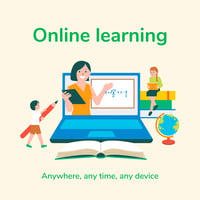Digital education has never been more popular than the recent times in which schools, colleges,...
Online Learning Revolutionizing K-12 Education
Traditional classroom learning has its benefits and limitations, but most significant impact the students ever had to face the learning opportunities bounded by geographical barriers, followed by cost. Prevalent daily issues people faced before the internet age began were such as, how far will be the right school near a child’s home. If not nearby, how to commute? Do parents have the financial means to place a child in a quality learning environment? Stretching beyond limits, how would a parent ensure that the lessons have been designed to meet and exceed standards? What about the interest level of students and the pace of learning? The list of doubts and issues that follow traditional education is endless. Let us discuss online learning program in detail.
The proliferation and development of online learning and virtual learning options are beginning to break down these barriers. Not only the online education has broken geographical boundaries, but the revolution in blended-learning and virtual programs have also started making a profound impact into customization in education, allowing students to learn at their own pace in ways that are tailored to their learning styles and interests, from teachers anywhere in the world. Likewise, for the benefit of teachers, with today’s technology, teachers can reach many more students.
The online learning revolution has already begun in the United States. As many as one million children (about two percent of the K-12 student population) are participating in some form of online learning. (1)
To this day, about 27 states offer statewide virtual schools that allow their students to take a class online, and 24 states and the District of Columbia offer students the opportunity to attend a virtual school full-time. (2)
Many districts have started offering online learning options that include supplemental instruction or blended-learning programs, which use ‘online learning’ in combination with face-to-face instruction. It is expected that enrollment in online learning programs will continue to grow over the next decade.
A recent survey showed that students are benefiting from online learning program. Although evidence about the effectiveness of K-12 online learning programs is limited, there is a reason to believe that students can learn effectively online.
In 2009, the Department of Education in the U.S published a meta-analysis of evidence-based studies of K-12 and post secondary online learning programs. (3) According to the study, “the students that took their class online performed better, on average than those taking the same course through traditional face-to-face instruction.” Online learning, also, has the potential to lower the cost of education, improve productivity, and reduce the financial burden on parents.
The Benefits of Online Learning
Considering the different ways that the Internet and information revolution have already improved and changed the lives of Americans, the potential educational benefits of online learning are very significant. Many scholars and analysts have examined the potential benefits of online learning program. (4)
Therefore, it is reasonable to expect virtual education to improve learning opportunities for American students in several ways:
- Access to quality teachers: A student’s chances of attending a quality school with excellent teachers largely depend on where she lives, which is shaped by her parents’ financial means. Online learning could give all students, regardless of where they live, access to the best teachers.
- Mass customization and optimization: Students can receive instruction at their own pace and in ways tailored to their unique learning styles and interests. Increased customization can make the learning process more productive and enjoyable.
- Increased flexibility: Virtual learning can provide students with greater flexibility in when and how they learn.
- Improved teacher’s flexibility: Also, online learning provides teachers with new career options and increasingly give teachers more freedom to instruct students in more productive ways.
- Improved productivity and efficiency: Online learning has the potential to improve productivity and lower the cost of education, thereby reducing the financial burden on parents.
- Innovation: Online learning will provide operators and instructors with incentives to innovate and develop new learning tools that could improve students’ learning options in ways unimaginable today.
Conclusion
Online learning has the potential to revolutionize education. Today, as many as one million American children are participating in some form of “online learning”, and it is growing exponentially. (5)
A study on “online learning program” found that students learn as well or better online as in a traditional school setting.
REFERENCES:
1. https://www2.ed.gov/admins/lead/academic/evalonline/evalonline.pdf
2. https://innovation.ed.gov/use-of-technology-in-teaching-and-learning/
3. https://www.ed.gov/k-12reforms
4. https://tech.ed.gov/files/2013/10/implications-online-learning.pdf
5. https://nces.ed.gov/fastfacts/display.asp?id=80
.png?width=100&height=100&name=Kapdec%20Logo%20(400px).png)


